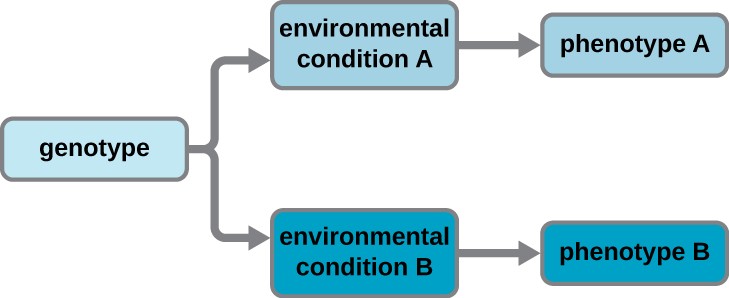11.1 – The Functions of Genetic Material
Learning Objectives
- Explain the two functions of the genome
- Explain the meaning of the central dogma of molecular biology
- Differentiate between genotype and phenotype and explain how environmental factors influence phenotype
DNA serves two essential functions that deal with cellular information. First, DNA is the genetic material responsible for inheritance and is passed from parent to offspring for all life on earth. To preserve the integrity of this genetic information, DNA must be replicated with great accuracy, with minimal errors that introduce changes to the DNA sequence. A genome contains the full complement of DNA within a cell and is organized into smaller, discrete units called genes that are arranged on chromosomes and plasmids. The second function of DNA is to direct and regulate the construction of the proteins necessary to a cell for growth and reproduction in a particular cellular environment.
A gene is composed of DNA that is “read” or transcribed to produce an RNA molecule during the process of transcription. One major type of RNA molecule, called messenger RNA (mRNA), provides the information for the ribosome to catalyze protein synthesis in a process called translation. The processes of transcription and translation are collectively referred to as gene expression. Gene expression is the synthesis of a specific protein with a sequence of amino acids that is encoded in the gene. The flow of genetic information from DNA to RNA to protein is described by the central dogma (Figure 11.2). This central dogma of molecular biology further elucidates the mechanism behind Beadle and Tatum’s “one gene-one enzyme” hypothesis (see Using Microorganisms to Discover the Secrets of Life). Each of the processes of replication, transcription, and translation includes the stages of 1) initiation, 2) elongation (polymerization), and 3) termination. These stages will be described in more detail in this chapter.

A cell’s genotype is the full collection of genes it contains, whereas its phenotype is the set of observable characteristics that result from those genes. The phenotype is the product of the array of proteins being produced by the cell at a given time, which is influenced by the cell’s genotype as well as interactions with the cell’s environment. Genes code for proteins that have functions in the cell. Production of a specific protein encoded by an individual gene often results in a distinct phenotype for the cell compared with the phenotype without that protein. For this reason, it is also common to refer to the genotype of an individual gene and its phenotype. Although a cell’s genotype remains constant, not all genes are used to direct the production of their proteins simultaneously. Cells carefully regulate expression of their genes, only using genes to make specific proteins when those proteins are needed (Figure 11.3).

Check Your Understanding
- What are the two functions of DNA?
- Distinguish between the genotype and phenotype of a cell.
- How can cells have the same genotype but differ in their phenotype?
Eye on Ethics
Use and Abuse of Genome Data
Why can some humans harbor opportunistic pathogens like Haemophilus influenzae, Staphylococcus aureus, or Streptococcus pyogenes, in their upper respiratory tracts but remain asymptomatic carriers, while other individuals become seriously ill when infected? There is evidence suggesting that differences in susceptibility to infection between patients may be a result, at least in part, of genetic differences between human hosts. For example, genetic differences in human leukocyte antigens (HLAs) and red blood cell antigens among hosts have been implicated in different immune responses and resulting disease progression from infection with H. influenzae.Because the genetic interplay between pathogen and host may contribute to disease outcomes, understanding differences in genetic makeup between individuals may be an important clinical tool. Ecological genomics is a relatively new field that seeks to understand how the genotypes of different organisms interact with each other in nature. The field answers questions about how gene expression of one organism affects gene expression of another. Medical applications of ecological genomics will focus on how pathogens interact with specific individuals, as opposed to humans in general. Such analyses would allow medical professionals to use knowledge of an individual’s genotype to apply more individualized plans for treatment and prevention of disease.With the advent of next-generation sequencing, it is relatively easy to obtain the entire genomic sequences of pathogens; a bacterial genome can be sequenced in as little as a day.[1] The speed and cost of sequencing the human genome has also been greatly reduced and, already, individuals can submit samples to receive extensive reports on their personal genetic traits, including ancestry and carrier status for various genetic diseases. As sequencing technologies progress further, such services will continue to become less expensive, more extensive, and quicker.However, as this day quickly approaches, there are many ethical concerns with which society must grapple. For example, should genome sequencing be a standard practice for everybody? Should it be required by law or by employers if it will lower health-care costs? If one refuses genome sequencing, does he or she forfeit his or her right to health insurance coverage? For what purposes should the data be used? Who should oversee proper use of these data? If genome sequencing reveals predisposition to a particular disease, do insurance companies have the right to increase rates? Will employers treat an employee differently? Knowing that environmental influences also affect disease development, how should the data on the presence of a particular disease-causing allele in an individual be used ethically? The Genetic Information Nondiscrimination Act of 2008 (GINA) currently prohibits discriminatory practices based on genetic information by both health insurance companies and employers. However, GINA does not cover life, disability, or long-term care insurance policies. Clearly, all members of society must continue to engage in conversations about these issues so that such genomic data can be used to improve health care while simultaneously protecting an individual’s rights.
Footnotes
D.J. Edwards, K.E. Holt. “Beginner’s Guide to Comparative Bacterial Genome Analysis Using Next-Generation Sequence Data.”

